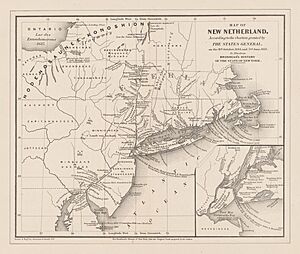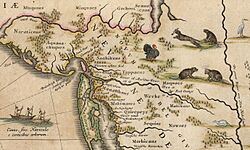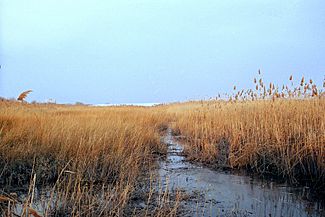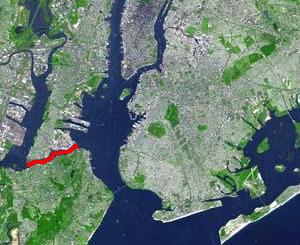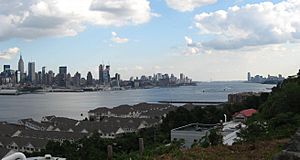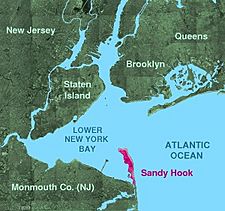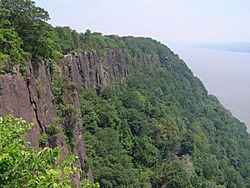List of New Netherland placename etymologies facts for kids
Nieuw-Nederland, also known as New Netherland, was a special place in North America during the 1600s. It was a colony belonging to the Republic of the Seven United Netherlands, which is now the Netherlands. This Dutch colony was located on the northeastern coast of North America.
The land claimed by the Dutch stretched from the Delmarva Peninsula all the way up to southern Cape Cod. Today, parts of this old colony are found in the states of Delaware, New Jersey, New York, and southwestern Connecticut. There were even small outposts in Pennsylvania and Rhode Island. The capital city of Nieuw-Nederland was New Amsterdam, which was built on the southern tip of Manhattan island, right on the Upper New York Bay. The busiest part of the colony was much like today's Tri-State area (New Jersey, New York, and Connecticut).
| Top - 0-9 A B C D E F G H I J K L M N O P Q R S T U V W X Y Z |
What Was Nieuw-Nederland?
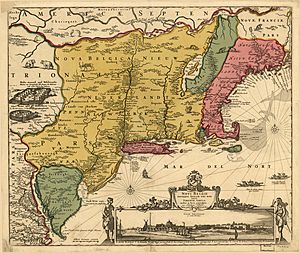
Many of the place names in Nieuw-Nederland came from two main languages: Dutch and the Algonquian languages spoken by Native Americans. Sometimes, names also came from the Iroquoian Mohawk people.
When Europeans first arrived, this land was home to many different Native American groups. Often, the names we use for these Native Americans today came from the names of their villages or their leaders, called sagamores. Both the Native Americans and the New Netherlanders often named places based on the land itself, like a unique shape, location, or natural feature.
Native American Names and Dutch Influence
The Lenape people had the most contact with the Dutch settlers. They were groups who moved around seasonally near New York Bay and along the Lower Hudson. They became known as the River Indians. Some of these groups included the Wecquaesgeek and Siwanoy (north and east of the Hudson River), the Hackensack, Raritan, Ramapough, and Tappan (to the west), and the Canarsee and Rockaway (on western Long Island).
The Munsee lived in the Highlands and the western Hudson Valley. The Susquehannock, who lived along the Zuyd Rivier, were sometimes called the Minquas. The Mohawk, an Iroquois group, lived in the Albany area and the Mohawk Valley. The Mahicans moved to the Housatonic River region after the Dutch arrived.
Native Americans used wampum (beads made from shells) to record information. The Europeans, whom the Native Americans called Swannekins or Salt Water People, used the Latin alphabet to write down the words they heard from the Wilden (Dutch for wild people), as they called the Lenape. These written names were often influenced by Dutch, which was the main language spoken in the colony. Many of these names are still used today, though their spelling and pronunciation have changed over hundreds of years.
Early Dutch settlers sometimes changed Native American names to sound more Dutch. In some cases, it's hard to tell if a name came from Dutch or a Native American language. Some names can even have several meanings! Words like Kill (meaning stream or channel), wyck (meaning district), and hook (meaning point) are often seen in place names from this time.
Famous Places and Their Names
A
Acquackanonk
This name comes from a Lenape group who lived along the Passaic River. It means "a place in a rapid stream where fishing is done with a net."
Achter Col
The Lenape called the area around Newark Bay Meghgectecock. The Dutch name Achter Col means "behind the peninsula," referring to Bergen Neck. It can also mean "rear pass" or "rear passage" because of the low land between Bergen Hill and the Watchung Mountains.
Amsterdam
Named after the Dutch capital city, which was originally a dam on the Amstel River.
Arthur Kill
This is a tidal strait that separates Staten Island from the mainland. The word Kill means "water channel." This name likely came from Achter Col, as English speakers moved into the area.
B
Barnegat
Originally Barendegat, meaning "Inlet of the Breakers," because of the rough waters in this channel.
Bedloe's Island
Now known as Liberty Island, this island was owned by Isaack Bedloo, a merchant from New Amsterdam.
Bergen
The name Bergen is believed to come from the Dutch word for "mountains" or "hills," describing the Palisades. Another idea is that it means "place of safety," because settlers returned here after fleeing Native American attacks during the Peach War.
Beverwyck
This name means "Beavertown" and referred to a fur-trading community north of Fort Orange. It was important for trade.
Block Island
Named after the explorer Adriaen Block, who used the island as a base to explore the Connecticut River and Long Island Sound.
Bloomingdale
Meaning "valley of flowers," this area was likely named after a village in the Netherlands. The Dutch settlers might have felt it reminded them of home, with its sandy bluffs and small valleys.
Bowery
Bouwerij was the old Dutch word for farm. The Dutch West India Company set aside land for farms north of New Amsterdam. The first farm was for the colony's director-general, Petrus Stuyvesant.
Broadway
Breede weg was a Dutch term meaning "wide path" or "broad way," which is exactly what Broadway was.
Breuckelen (Brooklyn Heights)
This was the first of the six Dutch towns in Brooklyn, settled in 1646. It was named after the town of Breukelen in the Netherlands.
The Bronx
Named after Jonas Bronck, the first European settler in this area. Native Americans called it Rananchqua or Keskeskeck.
Brooklyn
Early maps called western Long Island Gebroken Land, meaning "Broken Land," perhaps because of its many streams and tidal flats. However, most people believe the city was named after the Dutch town of Breukelen.
Bushwick
The last of the six Dutch towns in Brooklyn, settled in 1661 as Boswijck. This means "little town in the woods" or "woods district."
C
Canarsie
Canarsie comes from the Lenape language and means "fenced land" or "fort."
Cape May
Named after Cornelius Jacobsen Mey, a Dutch explorer.
Catskill
Kil is the Dutch word for a river inlet. This one is named after a Native American leader called Cats.
Cohoes
Once part of the Manor of Rensselaerswyck, this name is believed to come from a Mohawk phrase Ga-ha-oose, meaning Place of the Falling Canoe, referring to Cohoes Falls.
Collect Pond
This was a large freshwater pond near the southern tip of Manhattan. The name Collect is a changed version of the Dutch word kolch, meaning "a small body of water."
Communipaw
This was a summer camp and meeting place for the Hackensack Indians. The name means "big landing-place from the other side of the river."
Coney Island
Originally Konynen Eylant, which means Rabbit Island.
Connecticut
From the Mohegan word quinnitukqut, meaning "place of long tidal river."
Constable Hook
This land was given to Jacob Jacobsen Roy, a chief gunner in Fort Amsterdam. Konstapel's Hoeck in Dutch means "Constable's Point" or "Gunner's Point." A hoek means a "point" or "peninsula."
Cortlandt
Named after the important Van Cortlandt family, including Stephanus van Cortlandt, who was the first mayor of New York born in the colony.
Cresskill
Named for the watercress that grew in its streams, or kills.
D
Danskammer
This name literally means dance chamber or ballroom. In 1609, Henry Hudson's crew supposedly saw Native Americans dancing around a fire here and thought it was "the Devil's dance chamber."
Delaware
Named after Thomas West, Lord Delaware, who was a governor of the Jamestown Colony.
Dunderberg
This name means Thunder Mountain.
H
Hackensack
The meadowlands, river, and city are named after the Lenape Hackensack tribe. The name is thought to mean "place of stony ground" or "place where two rivers come together on low ground."
Halfmoon
Named in the 1800s for the crescent shape of the land between the Hudson River and Mohawk River. It's also the name of Halve Maen, the ship Henry Hudson sailed in 1609.
Harlem
Originally Nieuw Haarlem, named after a major Dutch city called Haarlem.
Haverstraw
One of the first places on North American maps, listed as Haverstroo, meaning oat straw. The Lenape often used straw to thatch their homes.
Hell Gate
Hellegat means Hell's Passage because of its very strong and dangerous currents.
Hempstead
This town was settled around 1644 by English colonists. It may have been named after Hemel Hempstead in the United Kingdom or the Dutch city of Heemstede.
Hoboken
This name is a Dutch version of the Lenape word for "tobacco pipe," likely referring to the soapstone found there, which was used to carve pipes. It could also come from Hoebuck, an old Dutch word for "high bluff," referring to Castle Point.
Hudson
The river, county, city, and many other places are named after the English sea captain Henry Hudson. He explored the region in 1609 on the Dutch ship Halve Maen ("Half Moon"), claiming the land for the Dutch.
J
Jamaica
Settled as Rustdorp (meaning "Rest Village") by the Dutch. The English later renamed it Jameco after a Native American word Yamecah, or a Lenape language word for "beaver."
K
Kill van Kull
This waterway separates Bayonne and Staten Island. Kill means riverbed or water channel. It likely came from Achter Col, meaning "channel from the neck."
Kinderhook
Kinderhoek means children's corner.
Kykuit
Pronounced "kye-kut," this Dutch word means "lookout." It's located on a high point near Tarrytown and Sleepy Hollow.
L
Long Island
Originally called Lange Eylandt by the Dutch, which translates directly to Long Island.
M
Mahwah
Mawewi means meeting place or place where paths meet.
Manhattan
From Manna-hata, as recorded in 1609. The word "Manhattan" has been translated as island of many hills. Other ideas include "place where timber is procured for bows and arrows" or simply "island."
Maspeth
From Mespeatches, meaning at the bad waterplace, referring to the many swamps in the area. Maspat was the first European settlement in Queens in 1642, but it was attacked by Native Americans and rebuilt later.
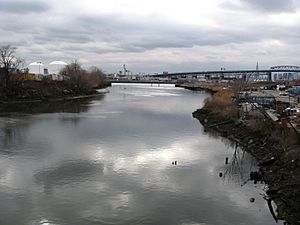
Midwood
Originally Midwout, meaning Middle woods, because of its dense forests. It was settled in 1652.
Minetta Lane
From "mintje kill," meaning "small stream" or "brook."
Moodna Creek
A changed version of the Dutch word moordenaars, meaning murderers. So, its original name was Murderers' Creek. Local stories say it's named after a massacre of early settlers.
N
Nassau
Named after the House of Nassau, one of the royal families of the Netherlands.
North River
Called Muhheakantuck or the river that flowed two ways by the Lenape. The Dutch called it Noort Rivier (North River). It was one of the three main rivers in New Netherland, along with the Versche Rivier (Fresh River) and the Zuid Rivier (South River). Today, this name still refers to the part of the Hudson River between Hudson County and Manhattan.
New Dorp
Originally Nieuw Dorp, meaning New Village, on Staten Island.
New Utrecht
The fifth of the six Dutch towns in Brooklyn, established in 1652 and named after the major Dutch city of Utrecht.
Nyack
From Nay-ak, meaning fishing place.
O
Orange
Named after the House of Orange, another royal family of the Netherlands, especially William III of England, who was also the Prince of Orange.
Ossining
Early Dutch maps show a Native American village here called "Sint Sinck," meaning "stone upon stone," referring to the limestone in the area.
Old Town
Originally Oude Dorpe, meaning Old Town, this was the first permanent settlement on Staten Island in 1651.
Overpeck Creek
Oever means a sloping bank and perk means border, so it means at the water's edge. The Lenape called it Tantaqua.
P
Paerdegat
This channel in Brooklyn connects to Jamaica Bay. A gat is an opening, and paarde is from the word for horse. So, Paerdegat means "horse gate."
Paramus
From Parampseapus or Peremessing, possibly meaning where there is worthwhile land or place of wild turkeys.
Passaic
The county, river, and city get their name from pahsayèk, meaning valley or water that flows through the valley.
Paulus Hook
This was a tidal island called Arresick by the Lenape. It was named after Michael Pauw's agent, who built a hut and ferry landing there. Hoek means a point or peninsula.
Pavonia
The first European settlement on the west bank of the Hudson River. It was named by its patroon Michael Reyniersz Pauw. Pavonia is a Latin version of his last name, which means peacock.
Peekskill
From Peeck's Kil. New Amsterdam resident Jan Peeck was the first European to have recorded contact with the Native Americans in this area.
Poughkeepsie
From a Native American phrase meaning the reed covered lodge by the little-water place, referring to a spring or stream flowing into the Hudson River.
R
Ramapo
The name for the mountains, river, and towns, meaning underneath the rock.
Raritan
The Raritan people, Raritan River, Raritan Bay, and towns are named after Naraticong, meaning river beyond the island (possibly Staten Island). It could also mean forked river or stream overflows.
Red Hook
From Roode Hoek. In Dutch, hoek means point or corner. This area in Brooklyn was named for the red clay soil on the point of land that stuck out into the East River. The Dutch settled it in 1636.
Rensselaerswyck
Named after the patroon Kiliaen van Rensselaer.
Robbins Reef
From the Dutch word rob or robyn, meaning seal. Seals would sometimes rest on the reef at low tide.
Rockaway
Meaning Place of sands, possibly from l'eckwa (sand) and auke (place).
The Rondout
A river that flows into the Hudson River. Rondout comes from the word redoubt, which is a type of fort. The Dutch built a fort near the river's mouth.
Rotterdam
Named after a major Dutch city that grew from a dam built on the Rotte river.
Rhode Island
The official explanation is that Adriaen Block named the area "Roodt Eylandt," meaning "red island," because of the red clay along the shore. The name was later changed to sound more English.
S
Sandy Hook
Sant Hoek, meaning sand corner or sand point. This peninsula was a key landmark for settlers sailing to Fort Amsterdam, Fort Orange, Staten Eylandt, Lange Eylandt, and Bergen before entering The Narrows.
Schenectady
Originally a Mohawk name for the settlement at Fort Orange, Schau-naugh-ta-da, meaning over the pine plains. Later, the Dutch used it to refer to the bend in the Mohawk River where the city is today.
Schuylkill
Discovered by Arendt Corssen of the Dutch West India Company, Schuylkill means hidden river. It refers to how the river's meeting point with the Delaware River was almost hidden by thick plants.
Secaucus
From the Lenape words Sukit (black) and achgook (snake), meaning black snakes. Snake Hill, in Secaucus, is a unique rock formation in the middle of the Meadowlands.
Sewanhacky
Sometimes meaning place of shells, referring to Long Island. Native people harvested shells here to make zewant or wampum (beads used as currency or for records).
Sing-Sing
Named after a band of Wappinger Native Americans in present-day Westchester County.
Spuyten Duyvil Creek
This channel connects the Hudson and Harlem Rivers. "Spuyten Duyvil" (modern Dutch: Spuitende Duivel) means Devil's Spout, because of its strong and wild currents.
Staten Island
Staaten Eylandt, meaning States Island. It was named after the governing body of the Netherlands in the 1600s, the States-General.
Sutphin
Sutphin Boulevard in Queens, New York, is named after the Van Sutphin family, who came from the Dutch town of Zutphen.
T
Lake Tappan
The region around Palisades Interstate Park and its people were named Tappaen by the Dutch. While it could mean cold water, it's more likely related to a word meaning dawn, connecting them to the Wappinger people, whose name means people of the east.
Teaneck
The origin is uncertain, but it might mean the woods or "neck where there are willows" (from the Dutch "tene" meaning willow).
Tenafly
From Dutch Tiene Vly or Ten Swamps, given by settlers in 1688. It could also mean at a meadow or willow meadows.
Throg's Neck
Named after John Throckmorton, an Englishman allowed by the Dutch to settle in the area they called Vriedelandt.
Turtle Bay
From duetel (modern Dutch: deuvel), meaning dowel, describing the original shape of the inlet on the East River.
V
Valatie
A village in Kinderhook, New York, settled by the Dutch in 1665. They named it "Vaaltje," which means "little falls."
Verplanck
A small village named after an early settler from the 1630s.
Versche Rivier
The Fresh River, now the Connecticut River, likely called this because its water was fresh, not salty.
Vriessendael
A small farm or homestead established in 1640, meaning Vries' Valley, named after its owner, David Pietersen de Vries.
W
Wall Street
Named after the Dutch word wal, meaning rampart or wall. A wall was built here in 1654 to protect New Amsterdam from possible attacks.
Wallabout Bay
From Wallen Bocht or Wallon's Bow, referring to the curve of the bay on the East River. It could also mean "inner harbor" from the River Waal.
Wallkill River
Known as Twischsawkin by Native Americans, meaning the land where plums abound. The river and its valley were important for farming and for resources like flint and chert, used for tools. European settlers named it after the Waal river in the Netherlands, or possibly after the Walloons, French-speaking Protestants who settled in the area.
Wappinger
From an Algonquian word for easterner. These were about 18 groups of Native Americans living on the eastern side of the Hudson River. The town of Wappinger and Wappinger Creek are named after them. Some also think it might come from the Dutch word wapendragers, meaning "weapon-bearers."
Watchung Mountains
The place of mountains from watchtsu, describing the three ridges west of the Meadowlands.
Watervliet
Part of the patroonship Rensselaerswyck, meaning "water flow," referring to land between high and low tide.
Weehawken
This name has several possible meanings: rocks that look like rows of trees, at the end of (the Palisades or a stream), or place of gulls.
Wilhelmus
A short-lived fort on the Zuyd Rivier in 1625. It was likely named after Het Wilhelmus, a popular Dutch song about Willem van Oranje, who fought for the Dutch people. This song later became the national anthem of the Netherlands.
Wiltwyk
A settlement on the west bank of the Hudson River established in 1652, possibly meaning Wild District. This was because farmers were often fighting in what were called the Esopus Wars. Today, it's known as Kingston, New York.
Wyckoff
Most commonly believed to come from the Lenape word wickoff meaning high ground or wickok meaning water. Another idea is that it's named after a judge, Pieter Claesen Wyckoff. The surname itself comes from Dutch words meaning district and court, or from a Friesian word for a settlement on a bay.
Y
Yonkers
From Jonkheer or Jonker, meaning "young gentleman" or "esquire." This was the title of Adriaen van der Donck, who owned the land where the city is now.
Z
Zuyd River
South River, which is now the Delaware River.
Zwaanendael
Sometimes Swaanendael, meaning swan valley. This was the site of the first Dutch colonial settlement in Delaware in 1631. It was destroyed and later became Lewes.
See also
- List of place names of Dutch origin in the United States
- Vlaie
- New Netherland settlements
- Forts of New Netherland
- List of place names in New England of aboriginal origin
- Metoac


